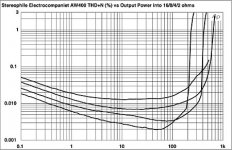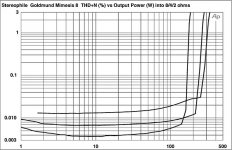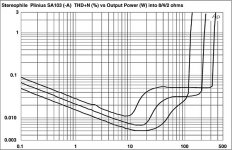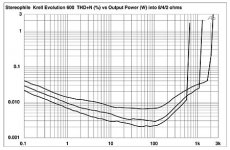I was there at the beginning of the Citation XX project. I, in fact, approved Matti Otala's coming to the USA to design amps and preamps. We had worked together, before, and this was a chance to do something really right. It was 1978.
The first design put forth by Matti Otala was all bipolar, based on a complementary video amp sort of design. Very good, by the way, fast and high current. My assignment was to make a 'bullet proof' tracking dual supply for the amp that would supply lots of current (not 200A, however) and be SOTA. I got started at my lab in California, and regularly visited HK as the need arose. I built a virtually 'bullet proof' dual linear tracking supply that actually tripped the 30 amp building breaker, rather than self-destruct with a direct short across it. Everything seemed OK. However, politics was in the wind, and apparently Matti did not like me sharing the 'limelight'.
What he did was take me aside and ask me to put out a bit of extra time and effort on the power supply, in order to speed up the development. I was, at the time, on 1/2 time or about 25 hours/week, so I had the time available, so I did it. However, when my billing changed, and I requested payment for twice the hours that I normally did, the S--- hit the fan! I felt bad that I did not 'cover myself' by asking my immediate supervisors first, but I presumed that Matti Otala would cover me, since it was at his request that I did the extra work. Well, he didn't, and they terminated me immediately, with annoyance. Nothing I could say would clear me, they thought I had overstepped my contract. Yup, Matti 'hung me out to dry'. Kind of sad, except I was offered a new proposition to have my own corporation: JC Audio Designs, by a Japanese investor. I just went on to found that company (another story entirely).
What about the aftermath? Well it took years for the Citation Amp to be built, and it was unrecognizable from its beginnings, but I was not shown the schematic. I saw that they had decided NOT to use a regulated power supply, that they had pretty good performance, and the amp had the unprecedented retail cost of $5000. When I saw it at CES, I mentioned to Matti that I, too, had made a new power amp for VMPS, called the 4Q-2, a 250W balanced bridge amp with 2A Iq (64W), regulated supply, and 3 air-blown heatsinks, and it was just down the hall. When I asked Matti, WHY the amp was so costly, he said it was partially because he used gold plated circuit boards.
Oh well, however decades later, I found that Matti Otala had ripped me off, taking MY complementary differential jfet input stage and using it instead of his original design, without telling me. I will never completely forgive him for that.
So he got me removed from my job as consultant at HK, AND he took my circuit topology (that I always knew was better than his), what a guy!
Over the decades, we remained distant colleagues. I was never brought in for another paper, etc. and we would say hello, if we met on occasion. Still, for all his political infighting, he really taught me a lot over the decades.
I'm starting to understand you more John, your edge that is , it's a shield , your a softy ....
Some Info on the XX..
http://www.popolo.com/citation.html
....
Last edited:
Hi,
They where made 32 years ago, there are parts that cannot be replaced and the numbers made where small. In 1980 the price 1.5 Million Yen.
Your best bet may be HiFido - Buy your used audio equipments .
Good luck.
Ciao T
Well here yah go, I guess someone feels this thing is worth something ...
Citation XX; XXP - Stereo Power Amplifier; Preamplifier Set | eBay
I was there at the beginning of the Citation XX project. I, in fact, approved Matti Otala's coming to the USA to design amps and preamps. We had worked together, before, and this was a chance to do something really right. It was 1978. [snip]
Oh well, however decades later, I found that Matti Otala had ripped me off, taking MY complementary differential jfet input stage and using it instead of his original design, without telling me. I will never completely forgive him for that.
So he got me removed from my job as consultant at HK, AND he took my circuit topology (that I always knew was better than his), what a guy!
Over the decades, we remained distant colleagues. I was never brought in for another paper, etc. and we would say hello, if we met on occasion. Still, for all his political infighting, he really taught me a lot over the decades.
Of course he made his TIM (also hardly that new an idea) into a virtual industry, and got a lot of things wrong along the way as well. But the combination of getting you into trouble with h/k AND ripping your designs off is unconscionable
But as you say, you have learned a lot.
I've had some analogous experiences, perhaps not so blatant. One unnamed but famous audio personage once visited me in my lab at UCLA. After some friendly exchanges I mentioned that I was surprised that settling time was not a parameter in audio circles, although added that with audio (as opposed to sample-holds etc. ahead of A/D converters) one had to be concerned not just with how soon you could look at a voltage or current to good accuracy, but also how you "got there" (overshoot/ringing being potentially audible). The person didn't quite scoff at the idea of settling time, but clearly discounted it as a parameter of significance.
Some years later I heard him waxing about a new amplifier from company S, touting its extraordinarily fast settling time.
A guy who managed to persuade a professor to refuse to let me make a pulsed-reset preamp for his infrared speckle interferometer, which made me decide to leave UCLA after 17 years of successful instrumentation, went on to prevent a grad student from observing any objects on the latter's observing list whe they were at the telescope. Then the observing list appeared, verbatim, in a grant proposal from this crook. But crime can pay for a while --- he went on to head the Space Telescope Science Institute for a time.
Of course, bcarso. Ortofon ripped off my patented Levinson JC-1 virtually part for part, AFTER I tried to get them to license it, from as early as 1974. I even put the mathematics up on a blackboard at Ortofon, in 1976, showing its inherent advantages over many designs. In 1978, they introduced it as their OWN design, at the Japan Audio Fair. I wrote a strong letter, both to Ortofon, and to the head of HK, who owned Ortofon at the time. I got a 'laughable' response. Should have taught me to keep my mouth shut, but I still give away too much, at times. I AM very sensitive of people taking an idea that I personally gave them, and taking it for their own, but the reason they have the information is because of my need to 'show off'! And so it goes.
Well here yah go, I guess someone feels this thing is worth something ...
Citation XX; XXP - Stereo Power Amplifier; Preamplifier Set | eBay
As a Recovering eBayer (HI BRAD!!!) I'm happy to say I wasn't even tempted to click on this, or even make a Best Offer
the combination of getting you into trouble with h/k AND ripping your designs off is unconscionable
+10
As a Recovering eBayer (HI BRAD!!!) I'm happy to say I wasn't even tempted to click on this, or even make a Best Offer
When Harvey Rubens and I sat in the audience at a local AES talk about grounding issues with pro equipment, the speaker started his talk with "Hi. I'm George P. Maggilicuddy*, and I have a Pin 1 Problem". Harvey and I spontaneously erupted:
HI GEORGE!!!
Not that many people in the audience found this amusing, whether because they were recovering alcoholics or just uninformed or possessed of a minimal sense of humor, we never knew.
Harvey and I are dangerous together. He was applying for a job at Harman one time, and the people who might have recommended the hire told me they didn't dare bring him in, as the two of us would just talk all day long
That was a danger when Steve Dove was there as well, but we satisfied our social contract by mock-strangling each other in the hall upon occasion. Again, few found this funny except the two of us.
Brad
*not his real name, which, sadly, I've forgotten.
This is what I'd like to make for myself - not as a commercial project, with the prospect of making it public domain once I have compiled a true list of materials, notes, instructions, etc.
Please do not ask me why I did something the way I did - obviously because I thought that would be best. Which may or may not be so.
But, I have my point of view, and others have theirs. So, this is an invitation to one and all to make their suggestions as they see fit, if they feel so inclined. Publically or in private messages, as they prefer.
No pun intended , but one could do way better with almost half
the components count....
I would rather call it OpAmpZilla.
Long time ago I tried symmetrical complementary topologies with multiple complementary output emitter followers, enormous power supply made from 2KV variac toroid, but they did not want to sound better than Tesla Mono-130 tube amp we had in laboratory, it was PITA!
How different each one s experiences can be , really.
I personnaly never got results as good as with symetrical
complementary dfferentials , whatever the competing topology....
Of course, bcarso. Ortofon ripped off my patented Levinson JC-1 virtually part for part, AFTER I tried to get them to license it, from as early as 1974. I even put the mathematics up on a blackboard at Ortofon, in 1976, showing its inherent advantages over many designs. In 1978, they introduced it as their OWN design, at the Japan Audio Fair. I wrote a strong letter, both to Ortofon, and to the head of HK, who owned Ortofon at the time. I got a 'laughable' response. Should have taught me to keep my mouth shut, but I still give away too much, at times. I AM very sensitive of people taking an idea that I personally gave them, and taking it for their own, but the reason they have the information is because of my need to 'show off'! And so it goes.
I knew a guy, head of parallel department, who made fun of my ideas on business meetings, then later presented them well wrapped as his own to the same board who knew truck manufacturing, but were ignorant in computer technologies. Like, when I offered system software and tools they were "bad". Later the same system software and tools were required for his application developers, and my earlier initiative turned into obligation, so instead of being good for pro-activity I was bad because did not supply his department in time. What I learned from him? To present ideas in such words that ignorant people can understand.
T., for decades I've trying to take a look under the hood, i.e. at its service manual. If you have any knowledge of where one might find it, I would be much obliged if you'd let me know, here or as a PM.
There's a guy on ebay selling the schematic for $6-7, for all the fuss you could at least satisfy your curiosity.
http://www.ebay.com/itm/ws/eBayISAPI.dll?ViewItem&item=200724277479
Last edited:
Of course, bcarso. Ortofon ripped off my patented Levinson JC-1 virtually part for part, AFTER I tried to get them to license it, from as early as 1974. I even put the mathematics up on a blackboard at Ortofon, in 1976, showing its inherent advantages over many designs. In 1978, they introduced it as their OWN design, at the Japan Audio Fair. I wrote a strong letter, both to Ortofon, and to the head of HK, who owned Ortofon at the time. I got a 'laughable' response. Should have taught me to keep my mouth shut, but I still give away too much, at times. I AM very sensitive of people taking an idea that I personally gave them, and taking it for their own, but the reason they have the information is because of my need to 'show off'! And so it goes.
Engineers love to talk engineering with other engineers. It drives management crazy! I have enough nondisclosure agreements to paper a wall, and I do take them seriously. But they are not very powerful as legal instruments.
One funny note: I sat in a meeting at company Au not too long ago. I of course had to execute an NDA. They wanted to make a powered speaker. They were good with algorithms I guess, but hadn't the foggiest notion about hardware development and real products. They thought I could help them select a connector though
Considerable months later, I got an email stating that "as you may have realized we decided to take a different direction [yeah I know the drill --- you found a manufacturer in China who said Don't pay for anything --- we do all design for you no charge!].
"But" they went on, "we want to compensate you for your time". So they told me how much to invoice them for and I did so (and for fun raised my rates, so that I could say that I'd charged $200/hr.
But the important thing for them was: there was now something legally binding on the NDA, as otherwise a contract is null and void if there is no benefit to the party that has agreed to the restrictions!
AFAIK the product never shipped, and observing their cluelessness, I'd have been very surprised if it had.
I still don't know why someone would put two 4148's in parallel with a red led for a ccs bias, or what the insight that leads to dvv's input configuration.
Looking at the 2SA970 and other data sheets, I only have gleaned one conclusion: The more proud a manufacturer is of the part, the more numbers and pictures they publish. Not a very scientific way to select a part, but a hint is a hint. The next hint is that they expect you to be using the part in about the middle of the graphs. Maybe slightly more scientific, but still a wag.
I am also surmising the 970/1085 would work quite well in the DH-120 input stage, but could only serve as the top of the cascode for the VAS due to limited power rating. The noise charts tell me how to pick R1 in the schematic. About .5 mA and abut 1K. I am totally blank on what the H parameter charts are trying to tell me. When I see the Cob-Vcb chart, this is showing me the Early effect? What do I do with this?
Side note, The On-Semi datasheet for the 2N5401 is identical to the Motorola, right down to the defects in font.
Looking at the 2SA970 and other data sheets, I only have gleaned one conclusion: The more proud a manufacturer is of the part, the more numbers and pictures they publish. Not a very scientific way to select a part, but a hint is a hint. The next hint is that they expect you to be using the part in about the middle of the graphs. Maybe slightly more scientific, but still a wag.
I am also surmising the 970/1085 would work quite well in the DH-120 input stage, but could only serve as the top of the cascode for the VAS due to limited power rating. The noise charts tell me how to pick R1 in the schematic. About .5 mA and abut 1K. I am totally blank on what the H parameter charts are trying to tell me. When I see the Cob-Vcb chart, this is showing me the Early effect? What do I do with this?
Side note, The On-Semi datasheet for the 2N5401 is identical to the Motorola, right down to the defects in font.
I knew a guy, head of parallel department, who made fun of my ideas on business meetings, then later presented them well wrapped as his own to the same board who knew truck manufacturing, but were ignorant in computer technologies. Like, when I offered system software and tools they were "bad". Later the same system software and tools were required for his application developers, and my earlier initiative turned into obligation, so instead of being good for pro-activity I was bad because did not supply his department in time. What I learned from him? To present ideas in such words that ignorant people can understand.
A years worth of Dilbert has most of this all wrapped up. Laugh or cry.
So why am I trying to remain sane by learning about amps? My work presentations are very technical and directed to a very technical audience. (big data architecture issues) No problem except my direct chief who is not that technical de-rated my performance evaluation because he does not know what I am talking about. I have to "communicate better". The target audience understands perfectly, and if I talked at his level, I would lose them. I don't care for RAP music. No problem, they don't make it for me. I don't criticize their talent because I don't understand their music. The target audience does understand when I put up an ERD with mauve background.
A years worth of Dilbert has most of this all wrapped up. Laugh or cry.
So why am I trying to remain sane by learning about amps? My work presentations are very technical and directed to a very technical audience. (big data architecture issues) No problem except my direct chief who is not that technical de-rated my performance evaluation because he does not know what I am talking about. I have to "communicate better". The target audience understands perfectly, and if I talked at his level, I would lose them. I don't care for RAP music. No problem, they don't make it for me. I don't criticize their talent because I don't understand their music. The target audience does understand when I put up an ERD with mauve background.
Executive summaries. Folksy analogies. Bullet points. And in the end, know what to kiss and when, as we are advised in the Deteriorata
Of course he made his TIM (also hardly that new an idea) into a virtual industry, and got a lot of things wrong along the way as well...
no, say it aint so...
at least don't try to support the criticism with "conventional engineering", Bode Sensitivy analysis, build dedicated hardware like Cordell...
- Status
- Not open for further replies.
- Home
- Member Areas
- The Lounge
- Sound Quality Vs. Measurements



